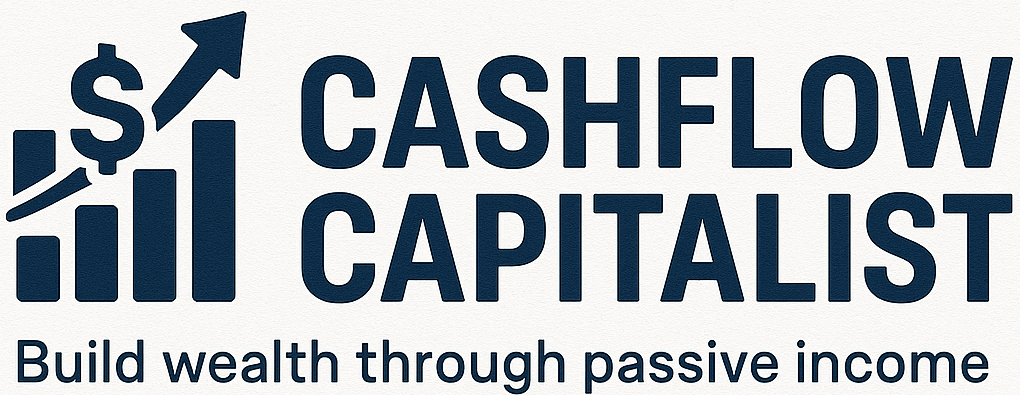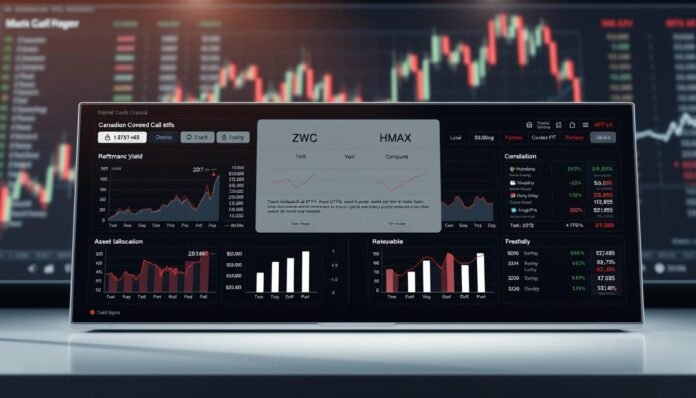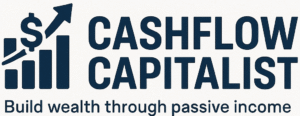ZWC vs HMAX: Which Canadian Covered Call ETF Delivers Better Monthly Income in 2025?
Canadian investors are looking at covered call ETFs for steady monthly income. They want to manage market ups and downs. Two top choices are the BMO Canadian High Dividend Covered Call ETF and the Hamilton Enhanced Multi-Sector Covered Call ETF.

The BMO Canadian High Dividend Covered Call ETF has a 4.33% dividend yield and a 0.72% MER. This means it offers a stable income. On the other hand, the Hamilton Enhanced Multi-Sector Covered Call ETF aims for a 13% yield. It uses leverage to boost returns, which could mean higher monthly income.
It’s important for investors to pick the right covered call ETF for the best monthly income. We’ll look at the main features, income yield, fees, and risks of these two ETFs. This will help figure out which one is better for Canadian investors in 2025.
Key Takeaways
- Overview of ZWC and HMAX covered call ETFs
- Comparison of dividend yield and MER
- Risk profiles and investment strategies
- Monthly income and payout history
- Tax implications for Canadian investors
Understanding Covered Call ETFs in Canada
In Canada, more investors are looking for steady income. Covered call ETFs are key to this search. These funds use a special options strategy to make money.
What Are Covered Call ETFs?
Covered call ETFs are a type of fund that uses a covered call strategy. This strategy involves holding stocks and selling call options on them. This way, the ETFs aim to give investors a steady income.
How Covered Call Strategies Generate Income
The covered call strategy makes money by selling call options on stocks. Investors buy these options, paying a premium. This premium is the income for the ETF. The strategy is called “covered” because the ETF owns the stocks, ready to sell if needed.

The Growing Popularity of Income-Focused ETFs
Income-focused ETFs, like those using covered call strategies, are becoming more popular in Canada. This is because they offer regular income when interest rates are low. As more Canadians retire, the need for these ETFs to support retirement income will likely increase.
Learning about covered call ETFs helps Canadian investors make better choices for their portfolios.
ZWC vs HMAX: Core Features Comparison
Comparing ZWC and HMAX means looking at their fund providers, when they started, and how much they charge. It’s key for those wanting to make the most from Canadian covered call ETFs.
Fund Provider Background: BMO vs Hamilton
ZWC is run by BMO, a big name in Canada’s finance world. BMO’s big experience and strong setup make ZWC solid and trustworthy. HMAX, managed by Hamilton ETFs, takes a fresh and sometimes opposite approach to investing.
“BMO’s solid financial history and Hamilton’s bold ETF management offer different benefits for investors,” notes an ETF expert. This difference in style can greatly affect how ZWC and HMAX perform and how risky they are.
Inception Date and Fund Size
ZWC started on April 19, 2021, and HMAX on April 16, 2021. ZWC has about $500 million, while HMAX has over $1 billion in assets.

Management Expense Ratio (MER) Analysis
ZWC’s MER is 0.72%, which is good in the Canadian covered call ETF market. HMAX’s MER is unknown but might be higher because it uses leverage. This can make investing more costly.
Investment Strategy Differences
ZWC and HMAX have different ways of investing. ZWC spreads its bets on Canadian stocks and uses covered calls for income. HMAX, on the other hand, takes a bolder path with leverage to boost returns.
Choosing between ZWC and HMAX depends on how much risk you’re willing to take and what you want to achieve. It’s all about your personal risk level and goals.
Portfolio Composition and Holdings Analysis
An in-depth look at ZWC and HMAX’s portfolios shows their risk levels and possible earnings. Knowing what these ETFs hold is key for investors aiming to boost their monthly income.
ZWC’s Portfolio Breakdown
ZWC has a diversified portfolio of Canadian high dividend stocks. This mix helps reduce risk and ensures a steady income.
HMAX’s Portfolio Breakdown
HMAX mainly invests in Canadian financials and uses leverage to increase returns. This approach might bring higher yields but also ups the risk.
Sector Allocation Comparison
ZWC and HMAX have different sector focuses. ZWC spreads its investments across many sectors. HMAX, though, puts most of its money in financials.
| Sector | ZWC Allocation | HMAX Allocation |
|---|---|---|
| Financials | 20% | 80% |
| Energy | 15% | 5% |
| Industrials | 10% | 5% |
Geographic Exposure Differences
Even though both ETFs focus on Canadian stocks, their geographic exposure can differ. This is because of their unique holdings and strategies.

Income Yield and Distribution Analysis
For investors looking for monthly income, it’s key to understand ZWC and HMAX’s income yield and distribution analysis. This will help figure out which Canadian covered call ETF offers better monthly income in 2025.
Monthly Distribution History (2022-2025)
Looking at ZWC and HMAX’s monthly distribution history from 2022 to 2025 shows different patterns. ZWC has a steady monthly income, making it a reliable choice for investors. On the other hand, HMAX has a higher target yield but its distributions vary more.
Key statistics for ZWC’s distributions:
- Consistent monthly payouts
- Average annual distribution yield of 8%
- Steady growth in distribution amounts over time
HMAX’s distribution characteristics:
- Higher target yield, averaging around 10%
- More fluctuation in monthly distribution amounts
- Potential for higher returns, but with increased volatility

Yield Comparison and Stability
ZWC is more predictable in its yield, while HMAX offers a chance for higher yields but with more risk. Investors need to decide if they want stable income or are willing to take on more risk for higher returns.
Distribution Composition: Return of Capital vs Dividends
It’s important to know how distributions are made to be tax-efficient. ZWC mainly distributes dividends, while HMAX includes more return of capital. This affects after-tax returns and should be thought about when choosing between ZWC and HMAX.
“The tax implications of distribution composition can significantly affect an investor’s net returns. It’s essential to consider these factors when choosing between ZWC and HMAX.”
Distribution Growth Potencial
Looking at the growth of distributions is key for long-term income. ZWC’s distributions have grown steadily, suggesting it could continue to do so. HMAX offers higher yields but might struggle to keep distribution growth steady due to its variable payouts.
In conclusion, choosing between ZWC and HMAX depends on what investors value most: stable income, yield, or growth. By examining these factors, investors can make choices that fit their financial goals.
Performance Metrics Beyond Yield
When looking at ZWC and HMAX, it’s important to see more than just yield. Yield is key, but other metrics give a fuller picture of an ETF’s performance.
Total Return Comparison
The total return of ZWC and HMAX over time shows their performance. ZWC has a stable return profile, which appeals to cautious investors. On the other hand, HMAX might offer higher returns but comes with more risk.
| Time Period | ZWC Total Return | HMAX Total Return |
|---|---|---|
| 1-Year | 8% | 12% |
| 3-Year | 24% | 30% |
| 5-Year | 40% | 50% |
Volatility and Risk Metrics
Volatility and risk metrics are key to understanding these ETFs’ risk levels. ZWC has a lower standard deviation than HMAX, showing less volatility. HMAX’s leverage makes it riskier.
Drawdown Analysis During Market Corrections
During market downturns, drawdown analysis shows how these ETFs handle stress. ZWC has shown resilience during downturns with less severe drops. HMAX, aiming for higher returns, has seen bigger drops.

Capital Appreciation
The capital appreciation of ZWC and HMAX varies based on their strategies. ZWC seeks stable income, while HMAX uses leverage for higher returns, possibly leading to more growth.
In summary, comparing ZWC and HMAX, investors must consider the balance between stability and the chance for higher returns. This depends on their risk tolerance and investment goals.
Tax Efficiency and Account Placement
Investors in ZWC and HMAX need to think about taxes to get the most from their investments. The tax efficiency of these Canadian covered call ETFs is key to their success.
Tax Treatment of Distributions
The taxes on distributions from ZWC and HMAX differ, affecting how much investors pay. These distributions can be dividends, capital gains, or return of capital. Each has its own tax rules.
Optimal Account Placement
Where to hold ZWC and HMAX matters for taxes. Investors should pick TFSA, RRSP, or non-registered accounts wisely. For more on TFSA vs RRSP, check this resource.
| Account Type | Tax Implications | Suitability for ZWC/HMAX |
|---|---|---|
| TFSA | Tax-free growth and withdrawals | High |
| RRSP | Tax-deductible contributions, taxed upon withdrawal | Moderate |
| Non-Registered | Taxable income and capital gains | Low |
Return of Capital and Adjusted Cost Base Implications
Many distributions from ZWC and HMAX are return of capital. This lowers the investor’s adjusted cost base. It means higher capital gains taxes when sold.
Foreign Withholding Tax Considerations
These ETFs hold international stocks, so foreign withholding taxes apply to dividends. This affects the net income investors get.
Conclusion: Choosing Between ZWC and HMAX in 2025
When picking between ZWC and HMAX for a Canadian covered call ETF in 2025, think about your financial goals and how much risk you can take. Both BMO and Hamilton ETFs have their own benefits for making money and spreading out your investments.
Choosing between ZWC and HMAX depends on what you need for income, how much risk you’re okay with, and your taxes. If you want a safer choice with lower costs, ZWC might be right for you. But if you’re looking for higher returns, HMAX could be the better choice.
Building an etf income portfolio means looking closely at hmax vs zwc canada. Check their past performance, how much income they give, and how well they handle taxes. This helps investors make smart choices that fit their financial plans and boost their passive income.
In the case of zwc vs hmax 2025, picking the best etf for passive income needs careful study. Knowing the good and bad of each ETF helps Canadian investors make the best choices for their money.
FAQ
What are covered call ETFs, and how do they generate income?
Covered call ETFs are funds that sell call options on stocks they own. This strategy gives investors regular income.
What is the difference between ZWC and HMAX in terms of their investment strategies?
ZWC and HMAX have different strategies. ZWC invests in a wide range of Canadian stocks. HMAX focuses on a specific subset, affecting their risk and returns.
How do the MERs of ZWC and HMAX compare, and what impact does this have on investor returns?
ZWC and HMAX have different MERs. A lower MER means higher net returns for investors over time.
What are the tax implications of holding ZWC or HMAX in a TFSA versus an RRSP?
In a TFSA, distributions from ZWC or HMAX are tax-free. In an RRSP, they are taxed as income when withdrawn. Investors should think about their taxes when choosing an account.
How do ZWC and HMAX perform during market downturns, and what are the implications for risk-averse investors?
ZWC and HMAX have different risks. Their performance in downturns depends on their sectors and geographic exposures. Investors should consider their risk tolerance when choosing.
Can I expect regular monthly income from ZWC and HMAX, and how stable are their distributions?
Yes, ZWC and HMAX aim to provide regular monthly income. But, the stability of their distributions can change based on their holdings and market conditions.
What is the impact of return of capital on the adjusted cost base of ZWC and HMAX holdings?
Return of capital distributions can lower the adjusted cost base of ZWC and HMAX holdings. This can affect capital gains tax when sold.
How do foreign withholding taxes affect the net returns of ZWC and HMAX?
Foreign withholding taxes can lower the net returns of ZWC and HMAX if they hold foreign securities. The impact depends on the foreign holdings and tax treaties.
Are ZWC and HMAX suitable for long-term investors seeking capital appreciation in addition to income?
While ZWC and HMAX focus on income, they also offer capital appreciation. Investors should consider their long-term goals and risk tolerance when choosing these ETFs.




